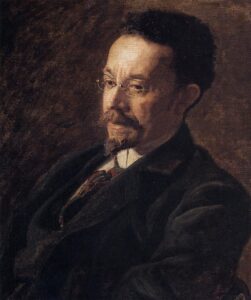Tanner’s Realistic Annunciation
BY ELIZABETH LEV
If the Virgin Mary is the most visually represented woman in history, then the Annunciation is the most favored scene from her life. Centuries of artists have fashioned images of this scene according to the spirituality of their age.
The late Roman Empire portrayed a royal princess; the Middle Ages favored a sinuous sylph, while the Renaissance conferred a naturalistic weight to her form. The repertoire of Incarnation imagery grew so vast, it became a daunting task to the modern era to renew this image without losing either its sense of sanctity or its power to teach. An unlikely painter in an unlikely place embraced this challenge: Henry Ossawa Tanner. His striking, innovative depiction of the Annunciation is now as timeless as those of the Renaissance and medieval masters.
Tanner was born in 1859 in Pittsburgh to a father who was a bishop in the African Methodist Episcopalian church and a mother who had escaped slavery. While a more obvious career path would have been to follow his father into ministry or join the industrial boom of the area, Tanner, like Giotto and Leonardo before him, felt the call of painting. In his own way, he ended up following both paths: His art preaches, and as the first successful African American painter, he paved the way for many other black artists to open studios and compete in the art world.
Even though Tanner faced many obstacles because of the color of his skin, his exceptional talent opened extraordinary doors. Trained by the world-renowned painter Thomas Eakins, Tanner settled in Paris, the most secular of cities, where he was drawn to paint religious subjects. He earned a showing in the Paris salon of 1896, and later that year he won a fellowship to go study the sites of the Holy Land. It was this direct contact with the land where Jesus walked that spawned his haunting Annunciation.
Tanner set the scene in an austere, confined space. While other eras loved lush gardens, sumptuous bedrooms, or majestic halls, Tanner was a student of the Age of Realism, and thus the white plaster walls are marred, while cheap, uneven tiles cover the floor and only a few utilitarian objects occupy the room. In this spartan chamber, Mary sits, hands clasped, knees pressed tightly together. Although the mussed bed covers and loose hair suggest that she has been awakened from sleep, her posture and expression indicate a girl who is awake and alive to the extraordinary event happening to her.
Tanner’s “realism” halts abruptly with the representation of the angel Gabriel. Following in the footsteps of Caravaggio, Tanner dared to eschew an anthropomorphic angel, replacing it with a dazzling manifestation of light. This luminous shaft, reminiscent of that fiery column that led Moses’ people out of slavery, provides a gateway, a potential opening, in the small walled cell. The radiant beam traverses the simple wooden shelf to form a cross: freedom, salvation, and eternity await, but not without sacrifice.
In this image is no unwitting girl blindly acquiescing to whatever is asked of her. She tilts her head slightly, looking up with an almost quizzical glance. This slight, pale creature, chosen for the most important task ever given to a human being, appears thoughtful, about to ask the question, “How can this be, since I have no relations with a man?” (Luke 1:34).
Amid the everyday objects are quiet symbols of the extraordinary persona about to take her place in salvation history. The earthenware vessels allude to what St. John Paul II described as the “first tabernacle”: her human body that would contain the Lord. The three urns also appear to evoke the Litany of Loreto’s invocations of Mary as “Vessel of Honor,” “Spiritual Vessel,” and “Singular Vessel of Devotion.”
A little bare foot peeks out from under the hem of her robe, sometimes touted by secular art history as Tanner defying traditional Christian iconography. Tanner’s studio, however, was just a few short blocks from Rue du Bac, the site of the miraculous apparition that resulted in the definitive iconography of the Immaculate Conception, where Mary’s bare foot emerges from her dress to crush the serpent. Tanner is depicting a young and gentle creature, conceived without stain of original sin, as she realizes the destiny unfolding before her.

Mary’s wall is swathed in red, while an indigo robe (a color known as “Tanner Blue”) lies bunched on the chair. The Virgin herself is clad in a simple striped robe, reminiscent of the tallit (Jewish prayer shawl), consonant with her attitude of prayer. At this moment the mortal woman, symbolized by the color red, receives the special grace of bearing Christ, symbolized with blue. When she rises and leaves the room, she will be the Mother of God and the Mother of the Church.
Perhaps this thoughtful, questioning Mary can speak more compellingly to the modern age than the submissive virgins or the dutiful princesses evoked in past ages. Tanner’s era saw spirituality challenged by science, which at the turn of the century was developing by leaps and bounds. The Eiffel Tower had “pierced” the heavens seven years earlier, and Nicholas Tesla was performing dramatic light experiments with electricity in Paris and beyond. Tanner himself had struggled with his faith but mastered his doubts and fears the same year he painted this work, writing to his parents on Christmas Day, “I have made up my mind to serve Him [God] more faithfully.”
A century later, technology continues to provoke existential questions, and the faith finds as many or more obstacles than those faced by Tanner. Yet this compelling image of Mary, who with prayerful discernment gazes into mystery, offers a path for all of us to fearlessly and knowingly follow the Lord through our real circumstances into his light.

